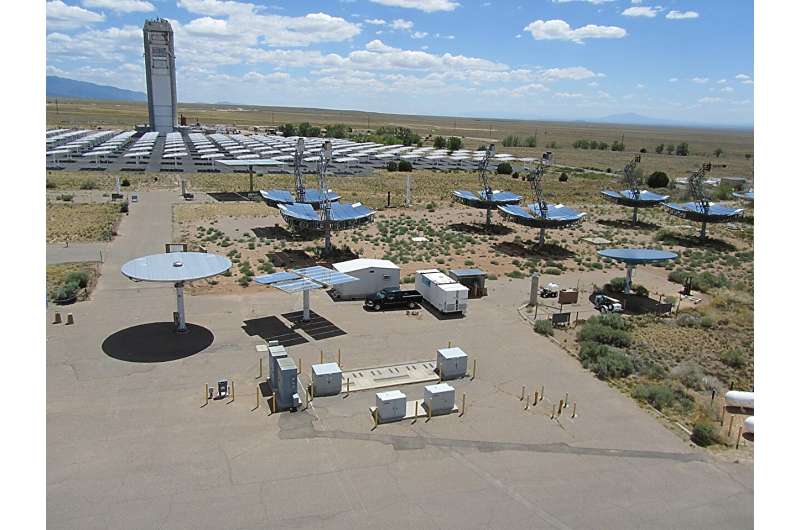This article has been reviewed according to Science X's editorial process and policies. Editors have highlighted the following attributes while ensuring the content's credibility:
fact-checked
proofread
New review discusses progress in the design of porous volumetric solar receivers

Amidst the growing demand for clean and renewable energy, different solar energy harvesting technologies are being actively developed. Among them, concentrating solar power (CSP) systems have emerged as a promising candidate for effectively producing electricity from sunlight. CSPs use multiple mirrors to focus sunlight onto a central receiver, which absorbs the sunlight and turns it into heat that is ultimately used to generate electricity through other mechanisms.
The solar receiver is one of the most important components of a CSP system. Over the past few decades, many studies have been conducted on porous volumetric solar receivers (PVSRs) made of porous materials. The pores not only allow for a deeper penetration and better absorption of sunlight but also provide a substantial surface area for the conduction of accumulated energy to the surrounding heat transfer fluid. However, despite such potential of PVSRs, many aspects still remain to be improved.
Recently, a research team led by Professor Ya-Ling He from Xi'an Jiaotong University in China has comprehensively reviewed the latest advances and challenges in the development of atmospheric and pressurized PVSRs. Their article was made available online on 18 June 2023, and will be published in Energy Reviews.
The review covers the progress in experimental research on PVSRs, presenting an overview of the successes and hurdles since 1980s, as well as the insights gained along the way. It then discusses the different criteria by which the performance of a PVSR can be evaluated: outlet air temperature and thermal efficiency of the system.
Unfortunately, directly comparing the performance of the two criteria remains challenging, since the possible range of values for the outlet air temperature and thermal efficiency vary greatly with test conditions. Thus, there is a need for a more standardized approach, which remains to be developed and validated.
The review next highlights developments in the theoretical aspects of PVSRs. These studies are aimed at accurately understanding fluid flow and heat transfer processes within the porous material of a solar receiver. Overall, scientists have employed two distinct strategies on this front: direct pore-scale and volume-averaging simulations.
Pore-scale simulations involve making sophisticated three-dimensional reconstructions of the structure of the porous media; these techniques are very computationally intensive and usually difficult to set up but can provide the most detailed insights. In contrast, volume-averaging simulations do not consider the detailed structure of the porous media and instead rely on a set of governing equations to make predictions. While these simulations are easier to set up, the considered parameters and equations must accurately match the actual system, which is challenging to ensure.
The article then summarizes recent advances aimed at improving the performance of PVSRs via approaches based on theoretical and experimental insights. One promising way for better volumetric solar absorption is through geometrical parameter optimization.
Put simply, such strategies involve making the porous media non-uniform to accurately match the non-uniform solar energy concentrated onto the receiver as well as capture the non-uniform characteristics of energy transfer within the porous material. "Some examples include building porous receivers composed of different layers or gradually varying structures," points out Prof. He.
The other main research front dedicated to performance optimization of PVSRs is spectrally selective absorption. Here, the objective is to adjust the material and structural properties of the receiver such that the energy absorption in the solar spectrum is maximized while the emission in the infrared spectrum is minimized.
Finally, the researchers highlight one of the main issues holding back PVSRs: the lack of evaluation methods to compare different designs. Moreover, there are still a few gaps to fill, both in the theoretical and experimental realms, before a meaningful breakthrough can be achieved in PVSRs that will enable their widespread commercial application. "Hopefully, this review will provide a better understanding of the development and research methods for PVSRs, and will inspire future studies aimed at improving their performance," comments Prof. He.
We too hope that the PVSR technology soon reaches the level of maturity needed to generate ample renewable energy for a sustainable future!
More information: Ya-Ling He et al, Advances in porous volumetric solar receivers and enhancement of volumetric absorption, Energy Reviews (2023). DOI: 10.1016/j.enrev.2023.100035

















